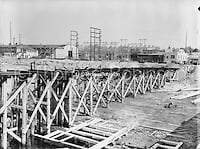
Albina Shipyard, also known as Albina Engine & Machine Works, constructed freighters during both world wars and eventually became a repair facility on the Willamette River in Portland, Oregon.[1] Albina was one of the city’s first major shipyards, but its use of asbestos had lasting, devastating effects on many workers.
Albina Shipyard History
The Albina Engine & Machine Works, formed in 1904 by William Cornfoot, gained popularity throughout the years for building and repairing vessels. It was located in the Albina neighborhood of Portland, on the Willamette River, near the Fremont Bridge.
Albina Shipyard workers produced a string of sub-chasers, warships, barges, tugboats, landing craft, fireboats, tankers, and freighters.
Following World War II, the shipyard began concentrating on commercial ships. Workers constructed barges, ferries, tugboats, and yachts. The switch to commercial vessels proved successful for the shipyard and continued until 1971, when it became Dillingham Ship Repair.[1]
In 1986, Dillingham became Cascade General and started focusing on work done at the Swan Island shipyard.[2] The company closed its original shipyard in Portland.[3]
How Did Albina Shipyard Use Asbestos?
Albina Shipyard played a huge role in boosting Portland’s economy and providing workers with gainful employment, yet it came at a cost.
As with most shipyards prior to the mid-1980s, the shipyard used asbestos in products, machinery, equipment, and more.[4]
Ships were constructed with hundreds of asbestos components. Albina workers came into contact with asbestos when building ships or making repairs. Albina and other shipyards had asbestos in these and other items:
- Machinery and equipment
- Welding gear and materials
- Fire protection gear
- Insulation
- Boilers
- Gaskets
- Pipes
- Furnaces
- Concrete
How Did Asbestos at the Albina Shipyard Harm Workers?
Shipyard workers have some of the highest rates of asbestos illnesses. Even workers who never handled asbestos materials were likely exposed.
When workers built ships or made repairs using asbestos materials, the fibers would come loose and contaminate the air. Anyone in the area could inhale asbestos fibers, which become lodged in the body and cause damage to cells and tissue.
Some of the workers at Albina developed mesothelioma, lung cancer, and asbestosis years after working at the shipyard.
Asbestos Lawsuits Involving Albina
One of the more well-known asbestos lawsuits against Albina Shipyard occurred when former worker James McCallister passed away from mesothelioma in 2002. According to court documents, McCallister worked as a shipyard carpenter, starting his career in 1956.
McCallister worked at three different Portland-area ports throughout his career, with Albina being the last one. Was Albina responsible for McCallister’s disease, or did the blame fall on the shoulders of the other companies? Those were the big questions when McCallister’s wife filed an asbestos lawsuit.
After several court hearings, along with new Labor rules, the court ruled that since Albina was the “last responsible” employer, the company was, in turn, financially responsible for McCallister’s illness.[5]
Albina Shipyard Closes
In 1987, Albina closed its doors permanently after Cascade General purchased it. The new company kept the popular Albina name for many years. In 2009, the company changed its name after complaints and lawsuits started pouring in, associated with the Albina name.
According to the Occupational Safety and Health Administration (OSHA), the site was contaminated with asbestos, various chemicals, oil, poisons, diesel fuel, petroleum, and other carcinogens.
Can Former Albina Workers Get Compensation for Asbestos Exposure?
Workers exposed to asbestos in the past have a right to seek compensation if they develop an asbestos illness. Asbestos attorneys help victims of exposure identify the companies responsible, file lawsuits, seek settlements, and file compensation claims with asbestos trust funds.
If you or a loved one worked at Albina and now has mesothelioma, contact a mesothelioma lawyer for a free consultation.

Mary Ellen Ellis
WriterMary Ellen Ellis has been the head writer for Mesothelioma.net since 2016. With hundreds of mesothelioma and asbestos articles to her credit, she is one of the most experienced writers on these topics. Her degrees and background in science and education help her explain complicated medical topics for a wider audience. Mary Ellen takes pride in providing her readers with the critical information they need following a diagnosis of an asbestos-related illness.

Dave Foster
Page EditorDave has been a mesothelioma Patient Advocate for over 10 years. He consistently attends all major national and international mesothelioma meetings. In doing so, he is able to stay on top of the latest treatments, clinical trials, and research results. He also personally meets with mesothelioma patients and their families and connects them with the best medical specialists and legal representatives available.
References
- Wreck Site. (n.d.). Albina Engine & Machinery Works Inc.
Retrieved from: https://www.wrecksite.eu/ownerBuilderView.aspx?109 - Marine Link. (n.d.). Portland’s Ship Repair Business Strengthened with Cascade General Sale.
Retrieved from: https://www.marinelink.com/article/ship-repair/portlands-business-strengthened-cascade-481 - Shipbuildinghistory.com. (2020, October 7). Albina Engine & Machine Works.
Retrieved from: http://shipbuildinghistory.com/shipyards/large/albina.htm - Hedley-White, J. and Milamed, D.R. (2008, September). Asbestos and Ship-Building: Fatal Consequences. Ulster Med. J. 77(3), 191-200.
Retrieved from: https://www.ncbi.nlm.nih.gov/pmc/articles/PMC2604477/ - FindLaw. (n.d.). Albina Engine Machine v. Director Office of Workers Compensation Programs BRB.
Retrieved from: https://caselaw.findlaw.com/us-9th-circuit/1547984.html


